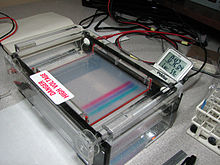Agarose gel electrophoresis
The agarose gel electrophoresis is a biochemical and molecular biological method in which nucleic acid strands ( RNA or DNA ) by gel electrophoresis are separated according to their size, their size and mass by comparison with DNA strands to determine known size.
principle
Agarose powder is dissolved in an electrophoresis buffer by briefly boiling , e.g. B. in TRIS acetic acid EDTA buffer ( TAE buffer ), in TRIS boric acid EDTA buffer ( TBE buffer ), in sodium borate buffer or in lithium borate buffer . When the agarose cools down, it forms a gel , the chain-like molecules of which are cross-linked by hydrogen bridges . The gel concentration is usually between 0.5 and 3% (m / V). The more concentrated the agarose, the smaller the pores that are in the gel and the firmer the cooled gel will be.
Before electrophoresis , the samples are mixed with sample buffer , which has been mixed with anionic dyes to mark the solvent front. Gel electrophoresis works like a sieve for molecules, in which larger molecules are retained more than smaller ones. When an electric field is applied , which causes the electrolytes used to generate an ion current , the negatively charged nucleic acid molecules pull through the gel mesh in the direction of the positive pole, which enables the strands to be separated according to their size. The size is estimated using a DNA ladder .
The gel either contains a DNA-binding dye during production (mostly ethidium bromide ), or in the sample buffer ( crystal violet ), or the gel is colored with a DNA-binding dye after electrophoresis, such as methylene blue , stains-all or ethidium bromide. This creates a characteristic, length-sorted band pattern of the areas in the gel with nucleic acids of different lengths, which is used for the subsequent photographic documentation of the bands of the separated DNA molecules. In the case of fluorescent dyes such as ethidium bromide, it is often necessary to illuminate the agarose gel with UV light and a UV filter on the camera. In a subsequent gel extraction to recover the nucleic acids, the UV irradiation is carried out as briefly as necessary to avoid DNA damage .
For shorter DNA sequences (less than 500 bp), high-percentage agarose gels or polyacrylamide gels are usually used. Variants of agarose gel electrophoresis are z. B. the electrophoretic mobility shift assay and pulsed field gel electrophoresis .
Molecular weight determination
The number of bases or base pairs is proportional to the chain length and approximately proportional to the respective molar mass . By comparing it with a DNA ladder , the length of a DNA or RNA can be determined.
literature
- Simple Protocol for Secondary School Hands-on Activity: Electrophoresis of pre-stained Nucleic acids on agar-agar borate gels .
- Steve Adkinsa, Margit Burmeister: Visualization of DNA in agarose gels as migrating colored bands: applications for preparative gels and educational demonstrations. In: Analytical Biochemistry . Vol. 240, No. 1, August 1996, pp. 17-23, PMID 8811874 , doi : 10.1006 / abio.1996.0325 .
- Friedrich Lottspeich , Joachim W. Engels , Solodkoff Zettlmeier Lay: Bioanalytik . 3rd edition, Spektrum, Heidelberg, 2012, ISBN 978-3827400413 .
- Cornel Mülhardt: The Experimenter: Molecular Biology / Genomics. Sixth edition. Spectrum Akademischer Verlag, Heidelberg 2008, ISBN 3-8274-2036-9 .
- J. Sambrook , T. Maniatis , DW Russel: Molecular cloning: a laboratory manual. 3rd edition (2001), Cold Spring Harbor Laboratory Press. ISBN 0-87969-577-3 .

